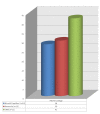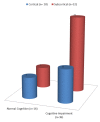Cognitive Impairment After Stroke
- PMID: 26543693
- PMCID: PMC4627858
- DOI: 10.7759/cureus.335
Cognitive Impairment After Stroke
Abstract
Background: Vascular dementia is extremely common and contributes to stroke-associated morbidity and mortality. The study of vascular dementia may help to plan preventive interventions.
Aims: To study the frequency of cognitive impairment after stroke in a series of consecutive patients with acute stroke, along with factors which influence it.
Methods: Fifty adults with acute infarct or hemorrhage (as seen on computed tomography of the brain) were included in the study. The National Institute of Health Stroke Scale (NIHSS) and Barthel's Index scores were done. Cognitive testing was done by PGI Battery of Brain Dysfunction (PGI-BBD) and Short Form of the Informant Questionnaire on Cognitive Decline in the Elderly (SIQCODE). Statistical analysis was by Student's t-test, Chi-square test, Fisher's exact test, and Mann-Whitney U test.
Results: Mean age of patients was 61.82 years; males and ischemic strokes predominated. Dementia was seen in 30%, cognitive impairment no dementia (CIND) in 42%, and normal cognition in 28% patients. Factors associated with vascular cognitive impairment included old age, male sex, low education, hemorrhages, recurrent or severe stroke, silent infarcts, severe cortical atrophy, and left hemispheric or subcortical involvement.
Conclusions: Up to 72% of patients have some form of cognitive impairment after a stroke. Secondary stroke prevention could reduce the incidence of vascular dementia.
Keywords: barthel index; cind; cognitive impairment; iqcode; nihss; psd; stroke; vascular dementia.
Conflict of interest statement
The authors have declared that no competing interests exist.
Figures
References
-
- Evolution of cognitive impairment after stroke and risk factors for delayed progression. del Ser T, Barba R, Morin MM, Domingo J, Cemillan C, Pondal M, Vivancos J. Stroke. 2005 ;36:2670–2675. - PubMed
-
- Preclinical vascular cognitive impairment and alzheimer disease: neuropsychological test performance 5 years before diagnosis. Ingles JL, Boulton DC, Fisk JD, Rockwood K. Stroke. 2007;38:1148–1153. - PubMed
-
- Poststroke memory function in nondemented patients: a systematic review on frequency and neuroimaging correlates. Snaphaan L, De Leeuw FE. Stroke. 2007;38:198–203. - PubMed
-
- Silent infarcts in patients with ischemic stroke are related to age and size of the left atrium. Mounier-Vehier F, Leys D, Rondepierre P, Godefroy O, Pruvo JP. Stroke. 1993;24:1347–1351. - PubMed
LinkOut - more resources
Full Text Sources
Other Literature Sources


